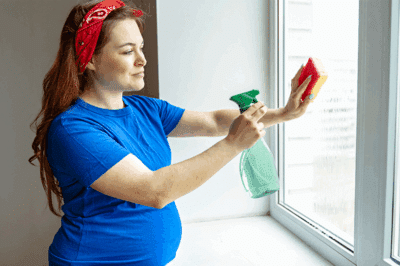Published on August 1st, 2025 and Updated on October 20th, 2025
Check out SneakPeek Gender Test to find out your baby’s gender as early as 6 weeks with over 99% accuracy!

When you’re pregnant, everything from the foods you love to the products you swear by must pass a new test: Will this help or harm my baby’s health?
If you missed your birth control pill or had unprotected sex, knowing how soon you can take blood test to detect pregnancy can help you act quickly. Once you know you’re pregnant, swap out harsh products for natural, pregnancy-safe cleaners—like vinegar, soap, and water—that are effective yet safe for your family, hands, and home surfaces.
Unfortunately, the adverse impacts of environmental toxins on reproductive and human health are simply a fact of modern life. While you can’t control every toxic ingredient, it is possible to make mindful choices about your detergents, soaps, and other cleaners, protecting your skin, your home, and your growing baby.
This begs the question: Are there pregnancy-safe cleaning products available?
The answer is yes—and knowing what to look for and how to make a few creative swaps can help you maintain a safe, green, and effective cleaning routine that supports your family’s well-being. Combining them with other first-trimester must haves helps ensure a safer home for you and your baby.
Cleaning while pregnant: What you should know
Pregnancy radically changes your physical and hormonal makeup. Understanding how soon you can take a pregnancy test can help you plan safer cleaning habits from the start. From living in a special immunological state to having hCG, progesterone, and other hormones flood your system, these shifts can make your body more vulnerable to potentially toxic environmental exposure.
Modern environments aren’t always conducive to optimal health. Chemicals from ammonia-based cleaners, bleach, and detergents can be inhaled, absorbed through the skin, or ingested as residue left on surfaces. In small amounts, you’re likely not at serious risk of health consequences.
However, in aggregate—or with repeated exposure over time—these toxins can elevate risks like:
- Fertility damage – Mounting evidence suggests a plethora of everyday chemicals may be linked to infertility in both men and women. These include endocrine disrupters like:
- Bisphenols
- Phthalates
- Parabans
- Pesticides, insecticides, and herbicides
- Heavy metals
- Birth defects – Chronic or repeated exposure to certain solvents, pesticides, and herbicides is associated with a higher risk of birth defects. Other substances, like excessive alcohol or caffeine, are also linked.
- Pregnancy loss – Certain chemicals, especially in high concentrations or with continued use, may contribute to miscarriage or stillbirth. One of these is known as PFAS, which can be widely found in clothes, household furnishings, and cookware.
It can be scary to learn about some of these agents. However, reading labels and understanding which ingredients to avoid is an easy way to limit your exposure.
There are also safe alternatives available. Knowing what substitutes to look for—as well as safer habits and practices you can adopt—can minimize harm while keeping your space clean.
6 cleaning habits and household products to avoid while pregnant
Once you confirm you’re pregnant, protect your health and your baby’s well-being by reviewing your cleaning habits and products. In particular, take note of these six common practices to avoid:
#1 Using products containing endocrine disruptors
Many cleaning products contain chemicals that interfere with normal hormonal rhythms. These are known as endocrine disruptors, and they can be particularly harmful during pregnancy.
Common endocrine disruptors include:
- Phthalates – Phthalates are frequently found in plastic packaging, as well as fragranced personal and household products, like air fresheners and cosmetics. They’re associated with impaired motor skills and language acquisition in young children, as well as several other health issues impacting adult health. While it’s not possible to eliminate phthalates from your environment, you can limit your exposure by purchasing phthalate-free products.
- Parabens – Commonly used as preservatives, parabens can be found in cleaning supplies, personal care products, and cooking utensils. These interfere with hormones by mimicking estrogen’s actions on the body; one study also found a link between elevated paraben levels and a higher risk of gestational diabetes.
Fortunately, you can limit your exposure by opting for fragrance-free products or using ones labeled “paraben-free.”
- Aerosol products – Aerosol sprays are easily inhaled and may contain volatile organic compounds (VOCs), which have been associated with headaches, nausea, and long-term respiratory problems. During pregnancy, it’s best to avoid them and opt for pump or wipe dispensers instead.
#2 Heating plastic food storage containers
Microwaving food in plastic containers may release harmful chemicals like BPA and phthalates into your food, especially if the container isn’t certified as microwave-safe.
As an alternative, you can store food in glass or ceramic containers and use them to reheat your leftovers. Alternatively, consider purchasing BPA-free or glass containers to keep your exposure low.
#3 Cleaning the litter box
Cat feces can contain a parasite called Toxoplasma gondii, which can lead to miscarriage or developmental problems in unborn babies. If possible, ask your partner or other household member to be in charge of litter box duties while you’re expecting. If you have to take care of it solo, just be sure to wear gloves and wash up thoroughly.
#4 Using bug sprays
Many bug sprays and insecticides contain DEET or other chemicals that may not be safe when you’re pregnant, especially with their potential for absorption.
If needed, with doctor’s permission, opt for natural, plant-based alternatives or homemade blends using vinegar or essential oils instead of chemical sprays, like:
- Lemon eucalyptus
- Citronella
Additionally, physical barriers like long socks, pants, and window screens can help you keep bugs at bay without having to use bug spray.
#5 Exposure to secondhand smoke
Cigarette smoke contains a myriad of chemicals that are known to put unborn babies in harm’s way, both before and after they’re born. Secondhand smoke is a key concern addressed in early pregnancy safety tips. Even occasional exposure can increase the risk of low birth weight, preterm labor, and SIDS (sudden infant death syndrome).
Whenever possible, it’s best to avoid environments where people are smoking, including outdoor spaces with lingering smoke.
#6 Exposure to pet products
Some flea collars, shampoos, and sprays contain pesticides and insecticides that could be harmful during pregnancy, especially with regular handling. Ideally, you want to choose pet care products labeled as non-toxic or made with natural ingredients.
Additionally, be sure to wash your hands after handling your pet or applying products, as animals can sometimes be a source of viruses.
Pregnancy-safe alternatives to protect your little one and your home
While you don’t need to throw away your entire collection of cleaning products, it is wise to consider putting them in a storage cabinet for the duration of your pregnancy.
As an alternative, opt for these safe cleaning products for pregnant women to ensure your space stays fresh while protecting you and your baby’s welfare:
- Vinegar –Use as a glass cleaner to tackle mirrors and windows.
- Baking soda –Use as a scrub to remove stubborn stains and buildup on your stove, toilet, or bathroom surfaces.
- Castile soap – Use this biodegradable cleaner for everything from your laundry, to your counters.
- HEPA-filter vacuums – These help eliminate dust and allergens without kicking them back into the air, keeping your air quality optimal.
- Microfiber cloths –Rather than chemical- and fragrance-heavy single-use wipes, opt for reusable, washable microfiber cloths.
These gentle, natural cleaners also support healthy skin while pregnant by reducing exposure to harsh chemicals. Keep your peace of mind by staying informed on skincare ingredients to avoid while pregnant. If you do purchase cleaning products, look for EPA-registered options—these are the safest ones to use. For instance, EPA-registered disinfectants use substances like hydrogen peroxide rather than ammonia or bleach.
Tips for environmental safety during pregnancy
During your pregnancy, the last thing you want to do is stress about every potential environment and product you come into contact with. Instead, maintain your peace of mind and your overall well-being by following a few easy-to-implement best practices:
- Avoid chemical-heavy environments – Whether you’re building is being repainted or your workplace uses potent industrial cleaners, it’s best to steer clear of chemical-heavy areas during pregnancy. If it’s unavoidable, try to stay in spaces that are well-ventilated or wear physical protection, like a face mask.
- Opt for fragrance-free products – Fragrances are a major source of hidden chemicals and potential risks for pregnant women. When in doubt, choose fragrances that use natural aromatics or safe essential oils for pregnancy.
- Be mindful of air pollution – If your weather app indicates poor air quality, it’s a wise idea to limit time spent outside. You might also consider investing in an air purifier with a HEPA filter to reduce exposure to pollutants, allergens, and debris.
- Keep an open window policy – When air quality isn’t a concern, it’s helpful to keep your space well-ventilated. Airing out your space with fans can also help reduce fumes and circulate clean, fresh air.
- Thoroughly wash produce – Washing and scrubbing produce—particularly non-organic produce—is an important step in reducing your risk of pesticide exposure. If you have the bandwidth for it, you might also consider a vinegar and baking soda rinse, which can be even more effective at removing chemicals.
- Always check your labels – If a product’s label seems vague or unclear, a good rule of thumb is to skip it. When in doubt, seek out transparent formulas and third-party badges for environmental safety. Always check the EWG database for safer options.
Finally, listen to the signals your body is sending. If you find yourself feeling dizzy, nauseous, or otherwise uncomfortable while cleaning or in a certain environment, stop what you’re doing and move to a different space. During pregnancy (and beyond), your comfort and safety are paramount.
Welcome your little one home with the SneakPeek® early gender DNA test
From preparing your house to nesting with your newborn, taking a conscious approach to parenthood empowers you to navigate the journey with confidence. And you can start your journey with as much information as possible, thanks to the SneakPeek® Early Gender DNA Test.
With this easy-to-use, at-home test, you can learn your baby’s predicted sex as early as 6 weeks into your pregnancy and with over 99% clinically proven accuracy.
Learn how it works and what to expect by exploring our collection of test kits today.
Editorial Policy
At SneakPeek, our commitment is to provide accurate, up-to-date, and reliable information to empower our readers. Our content is thoroughly researched, reviewed by medical experts, and fact-checked to ensure its credibility. We prioritize the well-being and education of our readers, and our editorial policy adheres to the highest standards of integrity and accuracy in all our articles.
Sources:
- National Library of Medicine. Environmental Toxins and Infertility. https://www.ncbi.nlm.nih.gov/books/NBK576379/
- National Library of Medicine. Maternal Immunological Adaptation During Normal Pregnancy. https://pmc.ncbi.nlm.nih.gov/articles/PMC7579415/
- Parents. 7 Hormones That Change During Pregnancy and What They Mean for You. https://www.parents.com/pregnancy/my-life/emotions/a-cheat-sheet-to-pregnancy-hormones/
- Centers for Disease Control. About Solvents and Reproductive Health. https://www.cdc.gov/niosh/reproductive-health/prevention/solvents.html
- Cleveland Clinic. Birth Defects. https://my.clevelandclinic.org/health/diseases/12230-birth-defects
- Yale School of Medicine. Commonly used chemicals associated with miscarriage, Yale School of Public Health study finds. https://medicine.yale.edu/news-article/commonly-used-chemicals-associated-with-miscarriage-yale-school-of-public-health-study-finds/
- National Library of Medicine. Endocrine Disruptors in Pregnancy: Effects on Mothers and Fetuses—A Review. https://pmc.ncbi.nlm.nih.gov/articles/PMC11432155/
- Harvard Health Publishing. Something else to avoid in pregnancy: Phthalates. https://www.health.harvard.edu/blog/something-else-to-avoid-in-pregnancy-phthalates-2019031516224
- Cleveland Clinic. Should You Worry About Parabens? https://health.clevelandclinic.org/what-are-parabens
- EPA. Aerosol Coatings: National Volatile Organic Compound Emission Standards. https://www.epa.gov/stationary-sources-air-pollution/aerosol-coatings-national-volatile-organic-compound-emission
- The Ohio State University. Are litter boxes safe during pregnancy? https://health.osu.edu/health/animal-health/litter-box-and-pregnancy
- National Library of Medicine. N,N-diethyl-meta-toluamide (DEET). https://www.ncbi.nlm.nih.gov/books/NBK582521/
- Centers for Disease Control. Smoking, Pregnancy, and Babies. https://www.cdc.gov/tobacco/campaign/tips/diseases/pregnancy.html
- Babylist. Everything to Know About Having a Pet While Pregnant. https://www.babylist.com/hello-baby/pregnancy-and-pets
- EPA. Selected EPA-Registered Disinfectants. https://www.epa.gov/pesticide-registration/selected-epa-registered-disinfectants
- Science Alert. A Microbiologist Explains The Best Way to Wash Fruit And Vegetables. https://www.sciencealert.com/a-microbiologist-explains-the-best-way-to-wash-fruit-and-vegetables







